In the Southern Hemisphere every year, many whale species migrate south to feed on the tiniest of prey – shrimp-like crustaceans called Antarctic krill. A new study shows that baleen whales feeding in the Southern Ocean eat nearly a third of their own body mass in krill every day.
Equally astonishing is the discovery that the whales inadvertently farm the krill. After whales consume iron-rich krill, they excrete plumes of nutrient-rich faeces, providing food for microscopic plants called phytoplankton that in turn feed the krill. And krill-chasing whales churn up krill droppings, manuring the water with iron to encourage yet more growth.
In addition to providing food for the whales, krill play a key role in drawing carbon out of the atmosphere. By eating those phytoplankton, which have absorbed carbon, and then excreting them, krill ’lock’ the carbon in the ocean.
They also regularly shed their exoskeletons, which sink to the ocean floor, taking carbon with them. It’s thought that the world’s krill population sequesters 0.3 million tonnes of carbon every day – equivalent to the UK’s daily domestic CO2 emissions.

© NATUREPL.COM / TONY WU / WWF
But human activity is threatening this sustainable way of life. Climate change is resulting in krill distribution shrinking southwards. In parts of the Southern Ocean, the Antarctic sea ice on which krill nurseries depend is melting.
And there’s growing international interest in krill fishery. This is a concern, particularly where it overlaps with the feeding grounds of whales, penguins and other species.
“Krill are the superheroes of the Southern Ocean,” says WWF’s polar adviser, Rod Downie. “They’re at the centre of the food web above the ocean floor, and they help to draw down and store vast quantities of carbon too.
”But they face grave threats. That’s why we’re working with our partners to better understand the role of krill in the carbon cycle, and how their distribution is changing. This will help us press for better protection for critical krill habitat.”
To highlight the importance of krill, and the threats they face, the first World Krill Day was held on 11 August. And WWF is calling for progress at the Commission for the Conservation of Antarctic Marine Living Resources (CCAMLR) on a Marine Protected Area (MPA) network in the Southern Ocean.
CCAMLR was set up in 1982, largely in response to concerns that increasing krill fishery would harm other wildlife in the region. There are already two MPAs in Antarctica, but CCAMLR is considering proposals for more.
”Changes in krill distribution and a growing interest from the fishing industry necessitates rapid action towards a network of marine protected areas incorporating krill habitat to support biodiversity and climate stability,” says Rod.
”We need to work with nature, not against it, in the fight against climate change.”
Watch our ‘Superheroes of the Southern Ocean’ animation
This short video explains the vital role of krill – not only as part of the marine food web but as climate change heroes – and the threats they face.
More to explore

Protecting whale highways
Human activities are creating a hazardous and often fatal obstacle course for migrating whales. Our new report highlights the growing dangers – and calls for urgent action to safeguard the oceans

